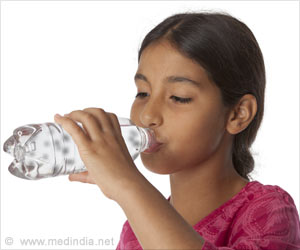Explains the health risks of plastic water bottles, such as toxins, bacteria, and environmental harm, and offers safer hydration options.

- Chemicals in plastic bottles can seep into water, risking health
- Repeated use of single-use plastic bottles increases toxin exposure
- Safer alternatives like home water filters provide pure hydration
Plastic particles in bottled water
Go to source).
Chemicals from plastic bottles can leach into water, posing health risks. #healthawareness #medindia #plasticbottle #bottledwater’
What Is Wrong with the Plastic Bottles?
In the past, water was being bottled in glasses, yet today, PET — a smooth, clear, and very thin plastic — took over. Still, PET bottles are designed for one-time usage, if they are reused the risks of various chemicals and toxins getting into the water reach dangerous levels.With regular reuse of these bottles, hazardous chemicals including di (2-ethylhexyl) phthalate (DEHP) are retained in the body and these have been understood to cause severe health impacts. Additionally, rough areas on plastic bodies are areas of weakening in their structure where bacteria can breed and this makes the bottles hard to clean thoroughly.
Health Effects Due to Chemical Leaching
Research evidently reveals that every time you have a beverage in a plastic container, that bottle may leach out toxins into the beverage if exposed to heat. Of these chemicals, antimony, for example, migrates from the plastic and dissolves in the beer the longer the bottles are stored and at higher temperatures.Recent research has described nausea, vomiting, and long-term health effects resulting from exposure to antimony. Also, water stored in plastic bottles contains higher levels of antimony with extreme consequences with time if consumed.
Let’s also talk about the studies that have been conducted about bottled water; how it contains microplastics. In the present study conducted by Mason, Welch, and Neratko (2018) analysed a total of 259 of the most popular bottled water brands across nine different countries and identified microplastics in 93 percent of the samples. Microplastics found in bottled water are believed to originate from both the cellophane and the process of bottling which has evoked concerns to do with these contaminants in bottled water.
Impacts of Plastic Bottles Environment
These bottles are not only an issue for the health of man but for the environment too. Plastic production in general is known to be energy intensive, particularly in the creation of such containers as bottles. Used bottles are usually thrown away, and they are likely to be dumped in the environment; it takes about 300 years for these bottles to become degradable, they add to environmental pollution and destroy the lives of animals in the water system. Consumers can avoid using plastic bottles and their impact on the planet by embracing alternatives that exist in the market.Choose NATURAL
Moving from using a plastic water bottle is not only a healthy decision, but also an environmentally friendly one. Options like stainless steel and glass bottles are great choices that offer a refreshing change. Stainless steel bottles are tough, lightweight, and keep your drinks hot or cold for hours—perfect for an on-the-go lifestyle. Glass bottles, though a bit heavier, give a pure taste with every sip and can be recycled when you’re done with them. If you need something more flexible, look for BPA-free reusable plastic bottles, which are safer than single-use plastics.These small swaps can make a big difference in reducing waste and limiting your exposure to unwanted chemicals.
Reference:
- Plastic particles in bottled water - (https://www.nih.gov/news-events/nih-research-matters/plastic-particles-bottled-water)
Source-Medindia










